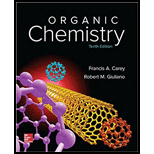
ORGANIC CHEMISTRY (LOOSELEAF)-PACKAGE
10th Edition
ISBN: 9781260008562
Author: Carey
Publisher: MCG
expand_more
expand_more
format_list_bulleted
Concept explainers
Question
Chapter 12.20, Problem 28P
Interpretation Introduction
Interpretation:
Whether the given ions are
Concept introduction:
Molecules, to be an aromatic, must obey Hückel’s rule of
Aromatic molecules are cyclic and planar and have cyclic conjugation.
Antiaromatic molecules are planar and have cyclic conjugation like aromatic molecules, but they have
Each double bond contributes two
Expert Solution & Answer
Want to see the full answer?
Check out a sample textbook solution
Students have asked these similar questions
Which nitrogen in the aromatic compound below is the least basic?
Which of the following species cannot be considered an electrophile?
Which of the following two compounds do you expect to be a better electrophile, and why?
Chapter 12 Solutions
ORGANIC CHEMISTRY (LOOSELEAF)-PACKAGE
Ch. 12.2 - Write structural formulas for toluene (C6H5CH3)...Ch. 12.3 - Prob. 2PCh. 12.5 - Prob. 3PCh. 12.5 - Prob. 4PCh. 12.6 - Prob. 5PCh. 12.6 - Chrysene is an aromatic hydrocarbon found in coal...Ch. 12.8 - Prob. 7PCh. 12.9 - As measured by their first-order rate constants,...Ch. 12.9 - Give the structure of the principal organic...Ch. 12.9 - Prob. 10P
Ch. 12.10 - Prob. 11PCh. 12.11 - Prob. 12PCh. 12.12 - Prob. 13PCh. 12.13 - Prob. 14PCh. 12.13 - Prob. 15PCh. 12.15 - The regioselectivity of Birch reduction of...Ch. 12.16 - Prob. 17PCh. 12.17 - Both cyclooctatetraene and styrene have the...Ch. 12.17 - Prob. 19PCh. 12.18 - Give an explanation for each of the following...Ch. 12.19 - Prob. 21PCh. 12.19 - What does a comparison of the heats of combustion...Ch. 12.20 - Prob. 23PCh. 12.20 - Prob. 24PCh. 12.20 - Prob. 25PCh. 12.20 - Prob. 26PCh. 12.20 - Prob. 27PCh. 12.20 - Prob. 28PCh. 12.21 - Prob. 29PCh. 12.21 - Prob. 30PCh. 12.22 - Prob. 31PCh. 12.22 - Prob. 32PCh. 12 - Write structural formulas and give the IUPAC names...Ch. 12 - Prob. 34PCh. 12 - Prob. 35PCh. 12 - Prob. 36PCh. 12 - Prob. 37PCh. 12 - Acridine is a heterocyclic aromatic compound...Ch. 12 - Prob. 39PCh. 12 - Prob. 40PCh. 12 - Prob. 41PCh. 12 - Evaluate each of the following processes applied...Ch. 12 - Prob. 43PCh. 12 - Prob. 44PCh. 12 - Prob. 45PCh. 12 - Prob. 46PCh. 12 - Anthracene undergoes a DielsAlder reaction with...Ch. 12 - Prob. 48PCh. 12 - Prob. 49PCh. 12 - The relative rates of reaction of ethane, toluene,...Ch. 12 - Both 1,2-dihydronaphthalene and...Ch. 12 - Prob. 52PCh. 12 - Prob. 53PCh. 12 - Prob. 54PCh. 12 - Prob. 55PCh. 12 - Prob. 56PCh. 12 - Each of the following reactions has been described...Ch. 12 - Prob. 58PCh. 12 - A compound was obtained from a natural product and...Ch. 12 - Prob. 60PCh. 12 - Suggest reagents suitable for carrying out each of...Ch. 12 - Prob. 62PCh. 12 - Prob. 63DSPCh. 12 - Prob. 64DSPCh. 12 - Prob. 65DSPCh. 12 - Prob. 66DSP
Knowledge Booster
Learn more about
Need a deep-dive on the concept behind this application? Look no further. Learn more about this topic, chemistry and related others by exploring similar questions and additional content below.Similar questions
- Predict the most likely sites of electrophilic aromatic substitution in each of the following molecules.arrow_forwardThe compound below undergoes electrophilic aromatic substitution to form a monosubstituted product. At which position will the electrophile going to attack?arrow_forwardWhich of the following are consistent with the requirements for aromaticity?I. A system with delocalized p electrons in a ring.II. 4n p electrons in the ring.III. All the ring atoms must be carbons.IV. (4n + 2) p electrons in the ring. Give the answer why.arrow_forward
- Which of the following would be LEAST reactive for electrophilic aromatic substitution?arrow_forwardAt what position would you expect electrophilic substitution to occur in the following substances?arrow_forwardRank the following from most to least reactive in Electrophilic Aromatic Substitution (EAS).arrow_forward
- Will the oxirane formed in either sequence rotate the plane of polarized light? Explain.arrow_forwardIdentify the ring which is more reactive towards electrophilic aromatic substitution.arrow_forwardWhat are the steps of the mechanism of reaction . Electrophilic aromatic substitution. Is it Ortho,para,meta ?arrow_forward
- Which of the following should be stabilized by resonance and why?arrow_forwardWhich position(s) on the ring would substitution occur when the aromatic compound shown undergoes bromination with Br2 , FeBr3 (when necessary)arrow_forwardArrange these compounds in order of reactivity towards electrophilic aromaticsubstitution, with the most reactive compound listed firstarrow_forward
arrow_back_ios
SEE MORE QUESTIONS
arrow_forward_ios
Recommended textbooks for you
 Organic ChemistryChemistryISBN:9781305580350Author:William H. Brown, Brent L. Iverson, Eric Anslyn, Christopher S. FootePublisher:Cengage Learning
Organic ChemistryChemistryISBN:9781305580350Author:William H. Brown, Brent L. Iverson, Eric Anslyn, Christopher S. FootePublisher:Cengage Learning

Organic Chemistry
Chemistry
ISBN:9781305580350
Author:William H. Brown, Brent L. Iverson, Eric Anslyn, Christopher S. Foote
Publisher:Cengage Learning